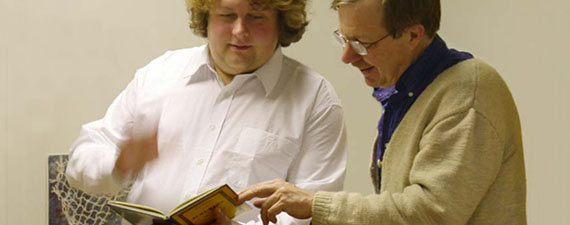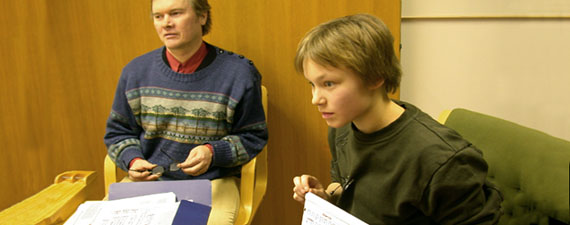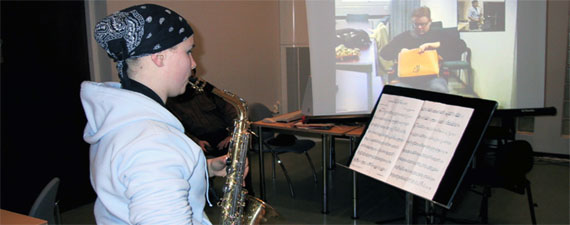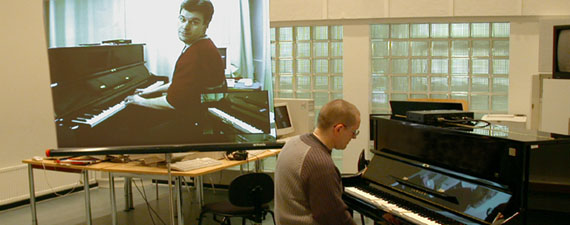New Challenges in Music Net Pedagogy
Examples of the pedagogical use of
videoconferencing technology
The paper was presented at the first round table of the Kuhmo Summer Academy, held in Kuhmo and Kostomuksha on July 28th - 30th, 2003. The presentation combines a traditional academic paper with clips of multimedia, illustrating four cases of distance education enabled through the use of audio enhanced videoconference (VC) systems.
The author acknowledges the importance of inputs from Matti Ruippo and Timo Haverinen, who contributed with their expertise in music pedagogy and sound engineering, respectively. All the photographs of this article were taken by Klaus von Matt.
The RealMedia clips illustrating the research and development effort may be activated by double-clicking the images. A free RealPlayer can be downloaded at the RealNetworks site.
The Centre of Expertise Program of the Finnish state stresses the importance of identifying local resources and their potential in unleashing regional development. New technology is being looked upon as a catalyst in this process. Finnish administrators and industry leaders have indeed stressed that there are big revenues, which can be expected from innovatory combination of high technology and other special skills, let it be forestry, mineral industry, bio chemistry and culture — even music.
But there is another side of the coin: At the same time our country is promoting its information society program. Here new technology is being looked upon as a force of creating better balance; a more even distribution in the production of services catering for basic needs of the population. In this perspective information technology is an enabler, a tool of producing democracy. It is expected to provide access to information, culture, education, health services etcetera.
I am going to focus on this latter aspect within the framework of my activities at the International Centre of Chamber Music — Virtuosi, where I am working as a researcher in real-time and multimedia net communication, especially in the service of music net pedagogy. I came to Kuhmo, because I saw it as an opportunity to play an effective role in the process of constructing a information society. I felt especially enthusiastic in the Virtual University program of our Ministry of Education, which had signaled an interest in funding a network for music educators.
I will concentrate on one branch of my research, which should give you some insight in how information technology can provide better music education services for rural areas situated far from the population centers. Videoconference technology provides new tools for distance educators.
Virtuosi in Kuhmo and the Kuopio Department of the Sibelius Academy has created infrastructures for piloting music net education. I didn't have much insight in this aspect of real time net communication, but my colleague Matti Ruippo has been using videoconference technology as a teaching aid since late 90s.
Here are four examples which demonstrate some of the procedures we have worked out. All pilots involve the Music School at Kuhmo. I will be pointing at some of the advantages that the new technology has to offer. Meanwhile you can also have a close look at what is being done in Virtuosi and the Music Education Online (MOVE) project.
Participating in a conductor masterclass held in Kuopio
The Music School in Kuhmo participates actively in the work of MOVE. As a first step the rector decided to offer every teacher training in basic skills of Internet communication and music technology.

Jukka-Pekka Kuusela prepares for a session of the conductor masterclass.
Conductor Jukka-Pekka Kuusela takes part in the courses of the Finnish Virtual University Music On-line project MOVE. In the clip Kuusela prepares himself for a conductor masterclass in a videoconference session distributed from Kuopio. The training takes physically place at Kuopio Music Centre, which makes a videoconference call to Virtuosi in Kuhmo.
While Matti Ruippo — the producer of the videoconference event — trims his mixer, the student conductors practice on stage in front of their partitures. Ruippo builds a connection to Kuhmo, where Philip Donner conducts a pilot in this new form of masterclass teaching. The sessions are undertaken with the orchestra E5. Conductor student Rauno Tikkanen delves in the clip into the second symphony of Jean Sibelius under the supervision of Jorma Panula.
Panula participates by commenting the student's performance. The maestro gives his guidelines from the first row of audience seats. Students on the stage and at VC units observe the session and take note of the teacher's advice.
What if... the kantele teacher lives in Helsinki
The Kuhmo Music School is producing a new conception of the usability of video technology as a method of music distance education. Folk music research and pedagogy is one of the special topics that the school is emphasizing. Video technology helps in implementing the ambitious program as Kantele classes are carried out in videoconferences.

Mirja Ruuskanen shows new exercise to her teacher Riitta Huttunen in Helsinki.
Riitta Huttunen worked in 1998-2000 as a researcher at the folk music project of the music school. Since then she has lived in Helsinki, but Riitta still supports students in Kuhmo by the means of distance education. Mirja Ruuskanen is studying kantele playing at the music school, but she doesn't have a fully competent teacher. In this clip Riitta and Mirja meet one another the first time in a videoconference, which provides skillful kantele training where there was none.
It seems that a talented pedagogues find their methods of visualization quite intuitively. The student also finds her ways without letting net communication become a insurmountable barrier. After a few distance education classes Mirja has also invented her own solutions of amplifying visual communication.
A rotating chair helps in producing a good angle without the help of technical video personnel. Soon Mirja learns how to attach the microphone, as well as carefully detaching the sensitive equipment. Despite a couple of problems the videoconference has advantages, which in a way compensate some of the shortcomings. The student may for instance study the streamed recording of the session at home by the means of Internet communication.
The saxophone teacher at a distance, in Oulu
Wind instruments, among them the saxophone presents extraordinary challenges to the developer of distance education systems. In addition to some other problems the saxophone has an exceptionally loud volume — especially compared to the conversation between teacher and students. The Kuhmo Music School lost its saxophone teacher in the fall 2002. Since then this function was fulfilled by a teacher at the Oulu Polytechnic.

Anni Heikkinen and her saxophone teacher Jaakko Nurila.
When it comes to saxophone training, special steps must be taken to assure that both the conversation and playing can be heard. Jukka Orajärvi from Oulu Polytechnic and Matti Ruippo from the Sibelius Academy are trying to figure out suitable volume settings. Jaakko Nurila is a teacher at the culture section of the Oulu Polytechnic. He has a keen interest in distance education. Anni Heikkinen and Anne Komulainen participate in the classes given by Nurila. In the clip Anni assumes the role of the student.
Some of the problems would have been avoided, if the situation could
be directly built on the experience of the previous session. The piloting equipment is only temporarily in the chamber music class of the Kuhmo Arts Centre which should have permanent videoconferencing facilities in order to produce long-lasting results.
This is an on-going undertaking. In the next phase of the project the researchers will try and bring a pedal which will help removing excessive volume differences. Obviously experimentation is a way of producing a functioning learning situation - not an end in itself.
Free accompaniment with MIDI piano in Kuopio
One of Virtuosi's partners, Xenex Telecom has developed a system, which connects a MIDI controlled piano to a VC session. The Music School has taken steps to organize a course in free accompaniment, in collaboration with the Kuopio Department of the Sibelius Academy. Apart from the videoconference unit the equipment at the Kuhmo pilot site includes a MIDI controlled piano. Obviously, there is another of these Yamaha Disklaviers at the other pilot site in Kuopio.

Jarmo Kaijansinkko brings his student to a new level of skills in free accompaniment.
Juha Jokelainen takes the role of the Guinea pig in our case study on free accompaniment pedagogy. The situation was not rehearsed. Jarmo Kaijansinkko is the tutor in this teachers training activity. Kaijansinkko is a theatre musician and pedagogue active in Kuopio.
Free accompaniment teacher Kaijansinkko translates the learning situation into an exciting dialogue, where he is constantly trying the limits of the student. In every exercise he seems add a new element of difficulty, which the student must overcome — and Juha Jokelainen does so quite successfully.
The solenoid triggered Yamaha Disklavier MIDI-piano has been used in remote areas of Northern Finland to provide piano classes at a distance. Xenex Telecom and Virtuosi still have many problems to solve before the product is ready for international distribution.
Concluding remarks
These examples demonstrate that Videoconferences seem to suit many kinds of music material. We were dealing with:
- Sibelius' second symphony
- Kantele folk music and the bells of Valamo monastery
- A lullaby performed by a charming saxophone player
- Piano accompaniment in various beat patterns
Although commercialization has worn out the power of Michelangelo's vision, it is almost as Bill Gates would be a prophet of the salvation of information technology, which provides us a variety of music quite close to our finger tips.
Kuhmo Music School in the periphery of Finland can offer:
- Top class international masterclass teaching in orchestra conducting
- Classes in kantele and saxophone, musical instruments which couldn't otherwise have been properly taught
- Teachers' training in free accompaniment
So it seems that new technology does hold many of its promises. Virtuosi and MOVE - the Music Education Online project - are using an effective approach which stresses careful multidisciplinary analysis and piloting before entering into wide scale dissemination of new methods and skills. This is being done by utilizing the piloting structures in Kuhmo and Kuopio, a new kind of research and development environment with direct contact to pedagogical practice.
Music is certainly a charming aspect of culture, but what is the relevance of all this to information society construction. Some of you may have read the news about Finland as the country where inequality between the metropolises and the periphery is the biggest in the European community. This information has been denied by some top bureaucrats who maintain it is being based on wrong evidence.
As to Kainuu region and Kuhmo I can confirm that the findings are totally correct. After a period of three years in Kuhmo I can say that instead of producing better balance we are facing a situation where differences are clearly growing. Please, have a look at some of the papers on my home pages and you will understand what the situation is.
I would like to question some of the assumptions of Finnish information society development.
The mainstream paradigm is based on the false assumption that Finland is composed of a few metropolises, which are having excellent resources for the utilization of information technology in nation building. Then there are smaller cities, where the resources are essentially the same but smaller. In this paradigm rural areas are seen as experiencing a similar situation as the cities, but having even less resources to solve their problems.
This line of thought doesn't conform to reality. It is true that resources are even scarcer in the remote periphery, but otherwise there certainly is no analogy here. We are facing a totally different situation which also calls for different solutions.
The minister who maintained that every Finn will have broadband services by 2005 was making an error because he had not analyzed the actual situation. Regional inequality is a structural problem producing little economical advantage and it cannot be solved by market driven evolution; as our leaders are maintaining.
My point is that a music researcher who ready to face the challenges of the periphery will quickly discover these and other fundamental problems. Moreover, he can even discover new solutions as soon as the problems have been identified.
How do we produce a balanced view of the conditions of net communication and net education in a country like Finland which gives priority to information society construction? What kind of research and development should be promoted, how can we produce appropriate tools of realtime net education, which answer the needs of the periphery?
A laboratory focusing on real-time net education could be a solution. In fact, such a laboratory is being proposed as one of the elements in the administrational experiment of Kainuu region. If the centers of expertise put an emphasis on the use of empirical and analytical approaches, they can become true agents of regional development — especially if the national and regional leaders are sensitive to the findings we can present; being ready to fund projects, which emerge from such carefully prepared initiatives.
I thank you for your attention. I hope you have got some insight on the use video technologies in the service of music distance education. As a special bonus you also got a taste of another branch of our activities. I am an author of netcasting authoring tools. The video presentation was prepared using tools which will be disseminated by Virtuosi.
— Ph. Donner



